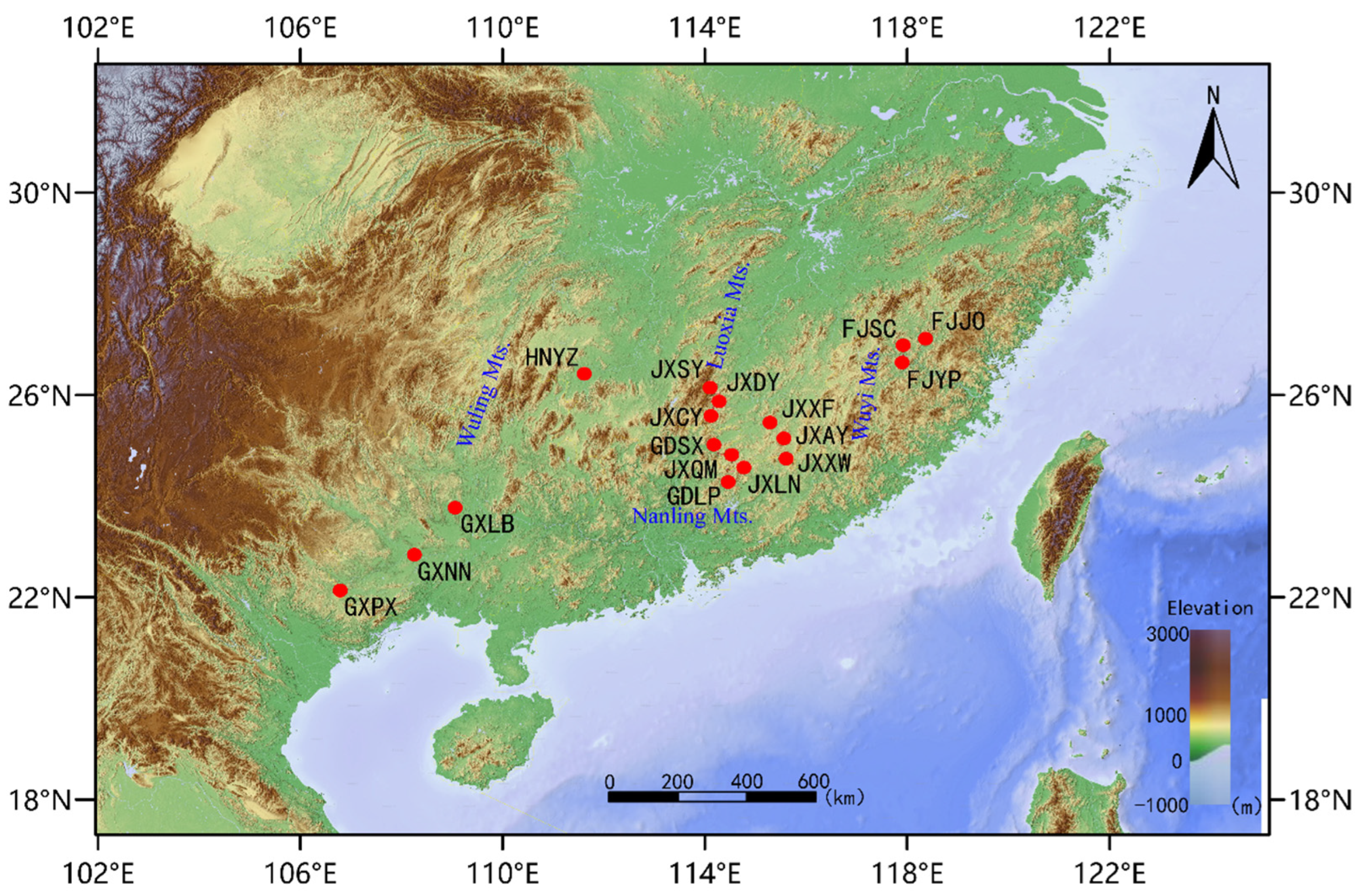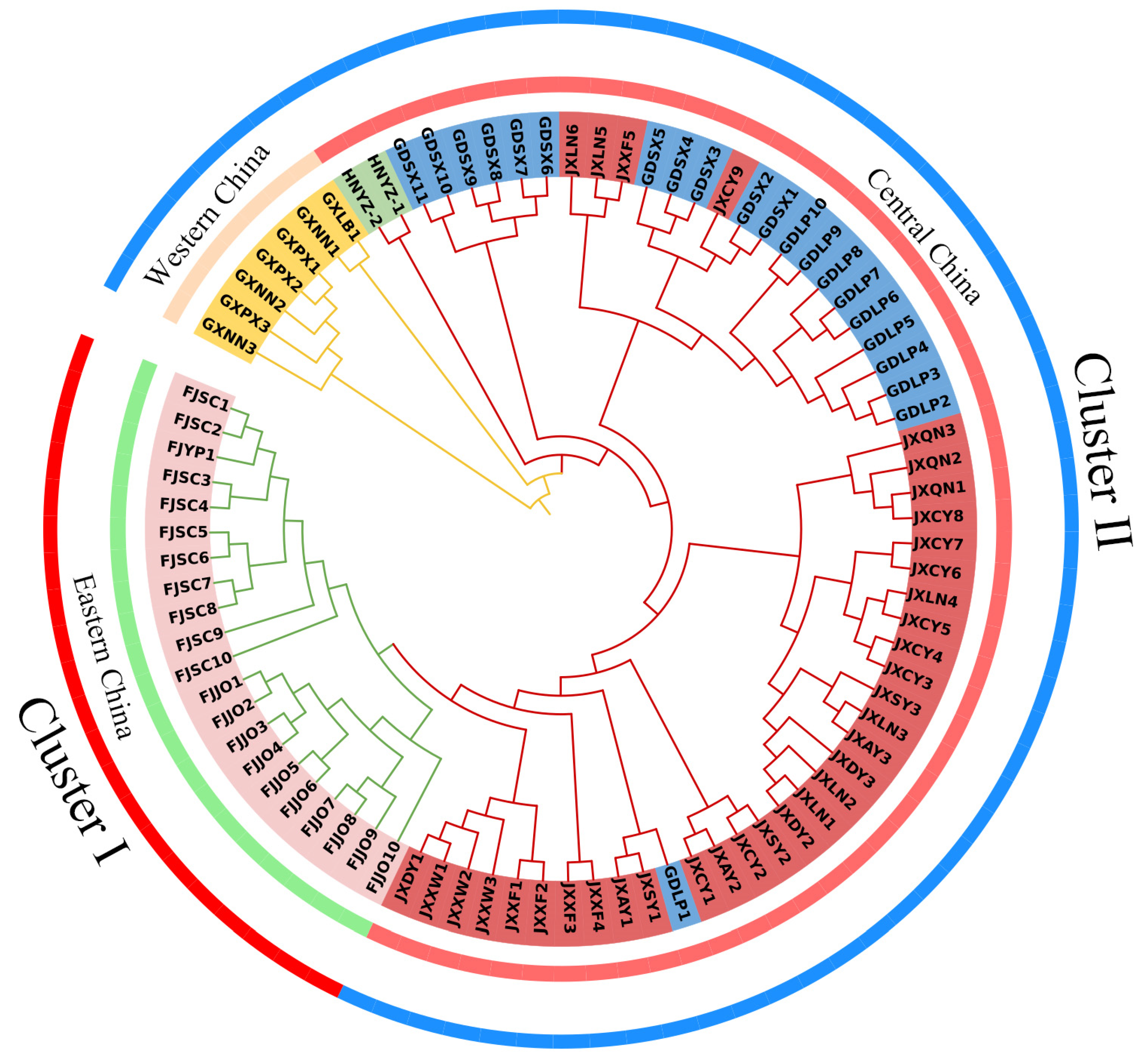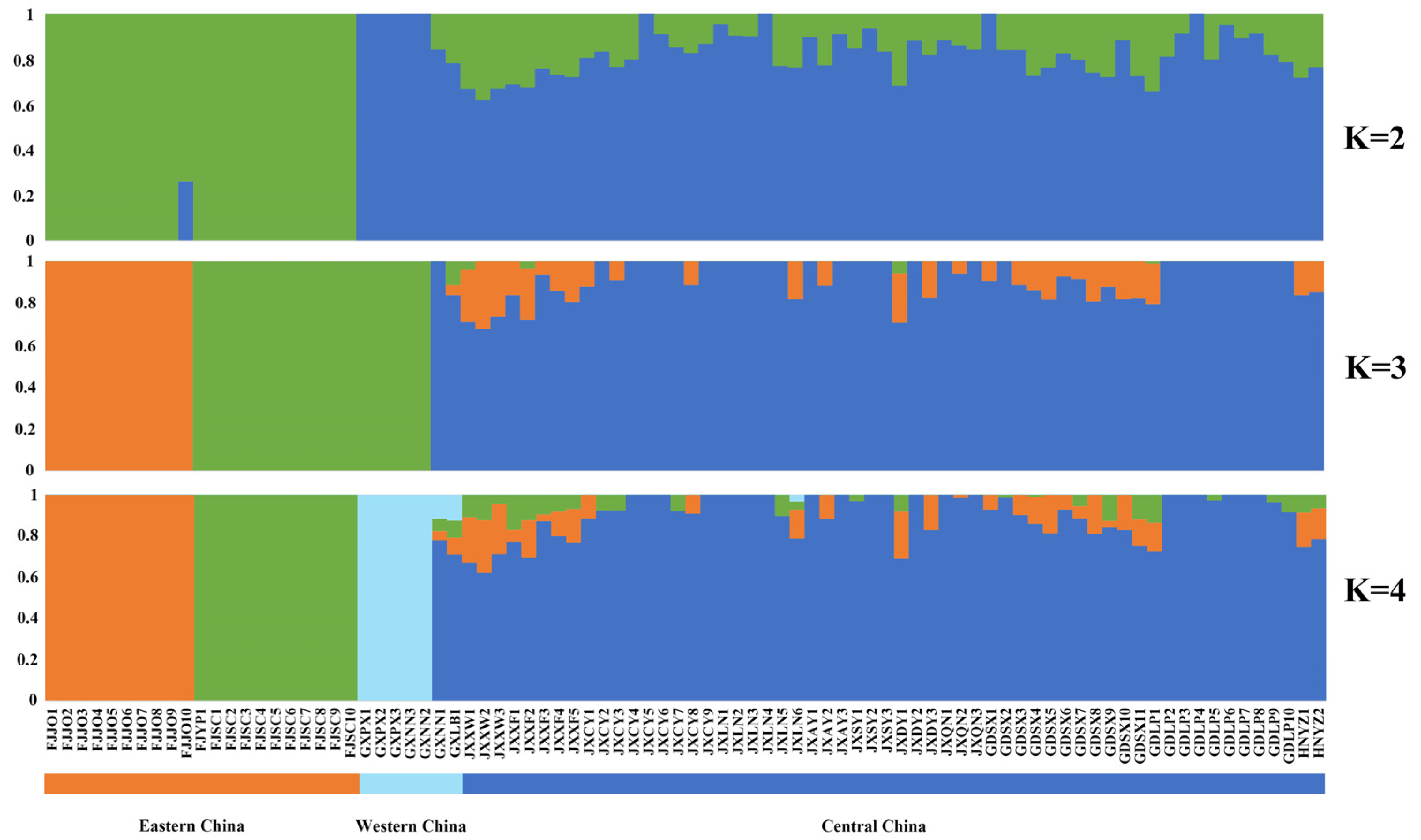Genotyping-by-Sequencing Study of the Genetic Diversity and Population Structure of the Endangered Plant Tsoongiodendron odorum Chun in China
Abstract
:1. Introduction
2. Materials and Methods
2.1. Plant Materials and DNA Isolation
2.2. GBS Library Construction and Population SNP Identification
2.3. Statistical Analysis
3. Results
3.1. GBS Analysis and SNP Identification
3.2. Population Genetic Structure
3.3. Genetic Diversity Analysis
4. Discussion
5. Conclusions
Supplementary Materials
Author Contributions
Funding
Data Availability Statement
Acknowledgments
Conflicts of Interest
References
- Liu, Y. Magnolias of China; Bright Sparks: Beijing, China, 2004. [Google Scholar]
- Fu, L.; Jin, J. Chinese Red Data Book of Rare and Endangered Plants; Science Press: Beijing, China, 1992; pp. 454–455. [Google Scholar]
- Nonić, M.; Šijačić-Nikolić, M. Genetic diversity: Sources, threats, and conservation. In Life on Land; Springer: Cham, Switzerland, 2021; pp. 421–435. [Google Scholar]
- Nugroho, K.; Terryana, R.; Manzila, I.; Priyatno, T.; Lestari, P. The Use of Molecular Markers to Analyze the Genetic Diversity of Indonesian Pepper (Capsicum spp.) Varieties Based on Anthracnose Resistance. Makara J. Sci. 2019, 23, 4. [Google Scholar] [CrossRef]
- Giang, T.; Minh, T.; Thi, L.; Ngoc, D.; Ajani, I. Chemical Constituents and Antimicrobial Activity of Tsoongiodendron odorum and Manglietia chevalieri Essential Oils from Vietnam. Chem. Nat. Compd. 2023, 59, 587–590. [Google Scholar]
- Fu, Y.; Liu, X.; Cheng, F.; Sun, J.; Qin, Z. Modification of the wood surface properties of Tsoongiodendron odorum Chun with silicon dioxide by a sol-gel method. BioResources 2016, 11, 10273–10285. [Google Scholar] [CrossRef]
- Jing, J.; Wang, J.; Kang, M.; Sun, W.; Huang, H. Isolation and characterization of microsatellite loci in Tsoongiodendron odorum (Magnoliaceae). Am. J. Bot. 2011, 98, e284–e286. [Google Scholar] [CrossRef] [PubMed]
- Huang, Y.; Zeng, Q.; Fu, J.; Kou, Z.; Chang, R.; Jin, H.; Zhang, W. Chemical constituents from Tsoongiodendron odorum Chun. Biochem. Syst. Ecol. 2011, 39, 209–212. [Google Scholar] [CrossRef]
- Van Eck, H.; van der Voort, J.; Draaistra, J.; van Zandvoort, P.; van Enckevort, E.; Segers, B.; Bakker, J. The inheritance and chromosomal localization of AFLP markers in a non-inbred potato offspring. Mol. Breed. 1995, 1, 397–410. [Google Scholar] [CrossRef]
- Park, T.; Kim, B.; Hutten, R.; van Eck, H.; Jacobsen, E.; Visser, R. Genetic positioning of centromeres using half-tetrad analysis in a 4x-2x cross population of potato. Genetics 2007, 176, 85–94. [Google Scholar] [CrossRef] [PubMed]
- Poland, J.; Rife, T. Genotyping-by-sequencing forplant breeding and genetics. Plant Genome 2012, 5, 92–102. [Google Scholar]
- Chung, Y.; Choi, S.; Jun, T.; Kim, C. Genotyping-by-sequencing: A promising tool for plant genetics research and breeding. Hortic. Environ. Biote. 2017, 58, 425–431. [Google Scholar] [CrossRef]
- Nguyen, T.; Lim, J. Tools for chrysanthemum genetic research and breeding: Is genotyping-by-sequencing (GBS) the best approach. Hortic. Environ. Biote. 2019, 60, 625–635. [Google Scholar] [CrossRef]
- Wirulda, P. Genotyping by Sequencing (GBS) for Genome-Wide SNP Identification in Plants. Methods Mol. Biol. 2023, 2638, 1–8. [Google Scholar]
- Qi, H.; Wang, N.; Qiao, W.; Xu, Q.; Zhou, H.; Shi, J.; Huang, Q. Construction of a high-density genetic map using genotyping by sequencing (GBS) for quantitative trait loci (QTL) analysis of three plant morphological traits in upland cotton (Gossypium hirsutum L.). Euphytica 2017, 213, 1–17. [Google Scholar]
- Moumouni, K.; Kountche, B.; Jean, M.; Hash, C.; Vigouroux, Y.; Haussmann, B.; Belzile, F. Construction of a genetic map for pearl millet, Pennisetum glaucum (L.) R. Br., using a genotyping-by-sequencing (GBS) approach. Mol. Breed. 2015, 35, 5. [Google Scholar] [CrossRef]
- He, J.; Zhao, X.; Laroche, A.; Lu, Z.; Liu, H.; Li, Z. Genotyping-by-sequencing (GBS), an ultimate marker-assisted selection (MAS) tool to accelerate plant breeding. Front. Plant Sci. 2014, 5, 484. [Google Scholar] [CrossRef] [PubMed]
- Liu, Y.; Yi, F.; Yang, G.; Wang, Y.; Pubu, C.; He, R.; Ma, W. Geographic population genetic structure and diversity of Sophora moorcroftiana based on genotyping-by-sequencing (GBS). PeerJ 2020, 8, e9609. [Google Scholar] [CrossRef] [PubMed]
- Siadjeu, C.; Mayland-Quellhorst, E.; Albach, D. Genetic diversity and population structure of trifoliate Yam (Dioscorea dumetorum Kunth) in Cameroon revealed by genotyping-by-sequencing (GBS). BMC Plant Biol. 2018, 18, 359. [Google Scholar] [CrossRef] [PubMed]
- Jiang, X.; Fang, Z.; Lai, J.; Wu, Q.; Wu, J.; Gong, B.; Wang, Y. Genetic diversity and population structure of Chinese Chestnut(Castanea mollissima Blume) cultivars revealed by GBS resequencing. Plants 2022, 11, 3524. [Google Scholar] [CrossRef] [PubMed]
- Islam, A.; Sanders, D.; Mishra, A.; Joshi, V. Genetic Diversity and Population Structure Analysis of the USDA Olive Germplasm Using Genotyping-By-Sequencing (GBS). Genes 2021, 12, 2007. [Google Scholar] [CrossRef] [PubMed]
- Chen, C.; Mitchell, S.; Elshire, R.; Buckler, E.; El-Kassby, Y. Mining conifers’ mega-genome using rapid and efficient multiplexed high-throughput genotyping-by-sequencing (GBS) SNP discovery platform. Tree Genet. Genomes 2013, 9, 1537–1544. [Google Scholar] [CrossRef]
- Gong, X.; Yang, A.; Wu, Z.; Chen, C.; Li, H.; Liu, Q.; Fa, X.; Zhong, Y. Employing genome-wide SNP discovery to characterize the genetic diversity in Cinnamomum camphora using genotyping by sequencing. Forests 2021, 12, 1511. [Google Scholar] [CrossRef]
- Huang, X.; Feng, Q.; Qian, Q.; Zhao, Q.; Wang, L.; Wang, A.; Han, B. High-throughput genotyping by whole-genome resequencing. Genome Res. 2009, 19, 1068–1076. [Google Scholar] [CrossRef] [PubMed]
- Cock, P.J.A.; Fields, C.J.; Goto, N.; Heuer, M.L.; Rice, P.M. The Sanger FASTQ file format for sequences with quality scores, and the Solexa/Illumina FASTQ variants. Nucleic Acids Res. 2010, 38, 1767–1771. [Google Scholar] [CrossRef]
- Chen, S.; Zhou, Y.; Chen, Y.; Gu, J. fastp: An Ultra-Fast All-In-One FASTQ Preprocessor. Bioinformatics 2018, 34, i884–i890. [Google Scholar] [CrossRef] [PubMed]
- Li, H.; Durbin, R. Fast and accurate short read alignment with Burrows-Wheeler transform. Bioinformatics 2009, 25, 1754–1760. [Google Scholar] [CrossRef] [PubMed]
- Li, H.; Handsaker, B.; Wysoker, A.; Fennell, T.; Ruan, J.; Homer, N. The Sequence Alignment/Map format and SAMtools. Bioinformatics 2009, 25, 2078–2079. [Google Scholar] [CrossRef] [PubMed]
- Levy, D.; Yoshida, R.; Pachter, L. Beyond pairwise distances: Neighbor-joining with phylogenetic diversity estimates. Mol. Biol. Evol. 2006, 23, 491–498. [Google Scholar] [CrossRef]
- Yang, J.; Lee, S.; Goddard, M.; Visscher, P. GCTA: A tool for genome-wide complex trait analysis. Am. Hum. Genet. 2011, 88, 76–82. [Google Scholar] [CrossRef] [PubMed]
- Excoffier, L.; Lischer, H. Arlequin suite ver 3.5: A new series of programs to perform population genetics analyses under Linux and Windows. Mol. Ecol. Resour. 2010, 10, 564–567. [Google Scholar] [CrossRef] [PubMed]
- Weir, B.; Cockerham, C. Estimating F-statistics for the analysis of population structure. Evolution 1984, 38, 1358–1370. [Google Scholar]
- Peakall, R.; Smouse, P. GenAlEx 6.5: Genetic analysis in Excel. Population genetic software for teaching and research—An update. Bioinformatics 2012, 28, 2537–2539. [Google Scholar] [CrossRef]
- Catchen, J.; Amores, A.; Hohenlohe, P.; Cresko, W.; Postlethwait, J. Stacks: Building and genotyping Loci de novo from short-read sequences. G3 Genes|Genomes|Genet. 2011, 1, 171–182. [Google Scholar] [CrossRef] [PubMed]
- Lee, K.; Ranta, P.; Saarikivi, J.; Kutnar, L.; Vreš, B.; Dzhus, M.; Kvist, L. Using genomic information for management planning of an endangered perennial, Viola uliginosa. Ecol. Evol. 2020, 10, 2638–2649. [Google Scholar] [CrossRef] [PubMed]
- Feres, J.; Guidugli, M.; Mestriner, M.; Sebbenn, A.; Ciampi, A.; Alzate-Marin, A. Microsatellite diversity and effective population size in a germplasm bank of Hymenaea courbaril var. stilbocarpa (Leguminnosea), an endangered tropical tree: Recommendation for conservation. Genet. Resour. Crop. Ev. 2009, 56, 797–807. [Google Scholar] [CrossRef]
- Frankel, O.; Soulé, M. Conservation and Evolution; Cambridge University Press: Cambridge, UK, 1981. [Google Scholar]
- Lande, R.; Barrowclough, G. Effective population size, genetic variation, and their use in population management. In Viable Populations for Conservation; Cambridge University Press: Cambridge, UK, 1987; Volume 87, pp. 87–124. [Google Scholar]
- Rossetto, M.; Weaver, P.; Dixon, K. Use of RAPD analysis in devising conservation strategies for the rare and endangered Grevillea scapigera (Proteaceae). Mol. Ecol. 1995, 4, 321–330. [Google Scholar] [CrossRef] [PubMed]
- Xu, Y.; Zang, R. Theoretical and practical research on conservation of Wild Plants with Extremely Small Populations in China. Biodivers. Sci. 2022, 30, 84–105. [Google Scholar] [CrossRef]
- Xiong, M.; Tian, S.; Zhang, Z.; Fan, D.; Zhang, Z. Population genetic structure and conservation units of Sinomanglietia glauca (Magnoliaceae). Biodivers. Sci. 2014, 22, 476–484. [Google Scholar]
- Yu, H.; Yang, Z.; Sun, B.; Liu, R. Genetic diversity and relationship of endangered plant Magnolia officinalis (Magnoliaceae) assessed with ISSR polymorphisms. Biochem. Syst. Ecol. 2011, 39, 71–78. [Google Scholar] [CrossRef]
- Xiang, C.; Zhu, X.; Zhang, H.; Qiu, D. Genetic Diversity of Endangered Plant Michelia wilsonii. J. Northwest For. Univ. 2009, 24, 66–69. [Google Scholar]
- Zhao, X.; Ma, Y.; Sun, W.; Wen, X.; Milne, R. High genetic diversity and low differentiation of Michelia coriacea (Magnoliaceae), a critically endangered endemic in southeast Yunnan, China. Int. Mol. Sci. 2012, 13, 4396–4411. [Google Scholar] [CrossRef]
- Eckert, C.; Samis, K.; Lougheed, S. Genetic variation across species’ geographical ranges: The central–marginal hypothesis and beyond. Mol. Ecol. 2008, 17, 1170–1188. [Google Scholar] [CrossRef]
- Stoeckel, S.; Grange, J.; Fernandez-Manjarres, J.; Fernández-Manjarres, J.; Bilger, I.; Frascaria-Lacoste, N.; Mariette, S. Heterozygote excess in a self-incompatible and partially clonal forest tree species―Prunus avium L. Mol. Ecol. 2006, 15, 2109–2118. [Google Scholar] [CrossRef] [PubMed]
- Rasmussen, K.; Kollmann, J. Low genetic diversity in small peripheral populations of a rare European tree (Sorbus torminalis) dominated by clonal reproduction. Conserv. Genet. 2008, 9, 1533–1539. [Google Scholar] [CrossRef]
- Luijten, S.; Dierick, A.; Gerard, J.; Oostermeijer, B.; Raijmann, L.; Den Nijs, H. Population size, genetic variation, and reproductive success in a rapidly declining, self-incompatible perennial (Arnica montana) in The Netherlands. Conserv. Biol. 2000, 14, 1776–1787. [Google Scholar]
- Kang, M.; Jiang, M.; Huang, H. Genetic diversity in fragmented populations of Berchemiella wilsonii var. pubipetiolata (Rhamnaceae). Ann. Bot. 2005, 95, 1145–1151. [Google Scholar] [CrossRef] [PubMed]
- Niu, Y.; Bhatt, A.; Peng, Y.; Chen, W.; Gao, Y.; Zhan, X.; Yu, Z. Genetic diversity and population structure analysis of Emmenopterys henryi Oliv., an endangered relic species endemic to China. Genet. Resour. Crop. Ev. 2021, 68, 1135–1148. [Google Scholar] [CrossRef]
- Deng, Y.; Liu, T.; Xie, Y.; Wei, Y.; Xie, Z.; Shi, Y.; Deng, X. High Genetic Diversity and Low Differentiation in Michelia shiluensis, an Endangered Magnolia Species in South China. Forests 2020, 11, 469. [Google Scholar] [CrossRef]
- Liu, Y.; Zheng, Y.; Li, C.; Lin, F.; Huang, P. Genomic Characteristics and Population Genetic Variation of Dalbergia cultrata Graham ex Benth in China. For. Res. 2022, 35, 44–53. [Google Scholar]
- Barros, J.; Winkler, F.; Velasco, L. Assessing the genetic diversity in Argopecten nucleus (Bivalvia: Pectinidae), a functional hermaphrodite species with extremely low population density and self-fertilization: Effect of null alleles. Ecol. Evol. 2020, 10, 3919–3931. [Google Scholar] [CrossRef]
- Chen, B.; Cole, J.; Grond-Ginsbach, C. Departure from Hardy Weinberg equilibrium and genotyping error. Front. Genet. 2017, 8, 167. [Google Scholar] [CrossRef]
- Kameyama, Y.; Furumichi, J.; Li, J.; Tseng, Y. Natural genetic differentiation and human-mediated gene flow: The spatiotemporal tendency observed in a long-lived Cinnamomum camphora (Lauraceae) tree. Tree. Genet. Genomes 2017, 13, 38. [Google Scholar] [CrossRef]
- Yang, A.; Zhong, Y.; Liu, S.; Liu, L.; Liu, T.; Li, Y.; Yu, F. New insight into the phylogeographic pattern of Liriodendron chinense (Magnoliaceae) revealed by chloroplast DNA: East–west lineage split and genetic mixture within western subtropical China. PeerJ 2019, 7, e6355. [Google Scholar] [CrossRef]
- Chen, T.; Lou, A. Phylogeography and paleodistribution models of a widespread birch (Betula platyphylla Suk.) across East Asia: Multiple refugia, multidirectional expansion, and heterogeneous genetic pattern. Ecol. Evol. 2019, 9, 7792–7807. [Google Scholar] [CrossRef]
- Wright, S. Evolution and Genetics of Populations: Variability within and among Natural Populations; University of Chicago Press: Chicago, IL, USA, 1978; p. 37. [Google Scholar]
- Slatkin, M. Gene flow and the geographic structure of natural populations. Science 1987, 236, 787–792. [Google Scholar] [CrossRef]
- Tan, J.; Zhao, Z.; Guo, J.; Wang, C.; Zeng, J. Genetic Diversity and Population Genetic Structure of Ervthrophleum fordii Oliv., an Endangered Rosewood Species in South China. Forests 2018, 9, 636. [Google Scholar] [CrossRef]
- Hartvig, I.; So, T.; Changtragoon, S.; Tran, H.; Bouamanivong, S.; Theilade, I.; Nielsen, L. Population genetic structure of the endemic rosewoods Dalbergia cochinchinensis and D. oliveri at a regional scale reflects the Indochinese landscape and life-history traits. Ecol. Evol. 2017, 8, 530–545. [Google Scholar] [CrossRef] [PubMed]
- Albaladejo, R.G.; Carrillo, L.F.; Aparicio, A.; Fernández-Manjarrés, J.F.; González-Varo, J.P. Population genetic structure in Myrtus communis L. in a chronically fragmented landscape in the Mediterranean: Can gene flow counteract habitat perturbation? Plant Biol. 2009, 11, 442–453. [Google Scholar] [PubMed]
- Tian, K.; Zhang, G.; Cheng, X.; He, S.; Yang, Y.; Yang, Y. The habitat fragility of Manglietiastrum sinicum. Acta Bot. Yunnanica. 2003, 25, 551–556. [Google Scholar]
- Wright, S. Evolution in Mendelian populations. Genetics 1931, 16, 97. [Google Scholar] [CrossRef]
- Allendorf, F. Isolation, gene flow, and genetic differentiation among populations. Genet. Conserv. 1983, 18, 51–65. [Google Scholar]



| Population Code | Sample Size | Locations | Longitude (°E) | Latitude (°N) |
|---|---|---|---|---|
| Eastern China | 21 | |||
| FJJO | 10 | Jianou, Fujian | 118.092–118.365 | 26.999–27.083 |
| FJSC | 10 | Shunchang, Fujian | 117.932–118.200 | 26.841–26.888 |
| FJYP | 1 | Yanping, Fujian | 117.921 | 26.734 |
| Central China | 58 | |||
| GDLP | 10 | Lianping, Guangdong | 114.441–114.451 | 24.467–24.469 |
| GDSX | 11 | Shixing, Guangdong | 114.062–114.273 | 24.784–24.954 |
| JXAY | 3 | Anyuan, Jiangxi | 115.512 | 25.132 |
| JXCY | 9 | Chongyi, Jiangxi | 114.038–114.367 | 25.693–25.855 |
| JXDY | 3 | Dayu, Jiangxi | 114.154 | 25.863 |
| JXLN | 6 | Longnan, Jiangxi | 114.529 | 24.624 |
| JXQN | 3 | Quangnan, Jiangxi | 114.416 | 24.693 |
| JXSY | 3 | Shangyou, Jiangxi | 114.151 | 26.017 |
| JXXF | 5 | Xinfeng, Jiangxi | 115.265–115.287 | 25.397–25.422 |
| JXXW | 3 | Xunwu, Jiangxi | 115.580–115.584 | 24.785–24.786 |
| HNYZ | 2 | Yongzhou, Hunan | 111.613 | 26.420 |
| Western China | 7 | |||
| GXLB | 1 | Laibin, Guangxi | 109.055 | 23.750 |
| GXNN | 3 | Nanling, Guangxi | 108.265–108.289 | 22.729–22.843 |
| GXPX | 3 | Pingxiang, Guangxi | 106.767 | 22.094 |
| Group | N | Ho | He | π | PIC | HWE |
|---|---|---|---|---|---|---|
| Eastern China | 21 | 0.167 | 0.112 | 0.15 | 0.055 | *** |
| Central China | 56 | 0.182 | 0.130 | 0.161 | 0.054 | *** |
| Western China | 9 | 0.178 | 0.108 | 0.167 | 0.048 | *** |
| Total | 86 | 0.179 | 0.123 | 0.160 | 0.053 |
| Source of Variation | df | Sum of Squares | Variance Components | Percentage of Variation% |
|---|---|---|---|---|
| Within populations | 153 | 238,588.69 | 1559.40 | 85.77 |
| Among populations | 12 | 42,424.73 | 185.55 | 10.20 |
| Among regions | 2 | 13,475.36 | 73.26 | 4.03 |
| Total | 167 | 294,488.78 | 1818.21 | 100 |
| Eastern China | Central China | Western China | |
|---|---|---|---|
| Eastern China | 0 | 13.639 | 9.750 |
| Central China | 0.018 | 0 | 9.366 |
| Western China | 0.025 | 0.026 | 0 |
Disclaimer/Publisher’s Note: The statements, opinions and data contained in all publications are solely those of the individual author(s) and contributor(s) and not of MDPI and/or the editor(s). MDPI and/or the editor(s) disclaim responsibility for any injury to people or property resulting from any ideas, methods, instructions or products referred to in the content. |
© 2024 by the authors. Licensee MDPI, Basel, Switzerland. This article is an open access article distributed under the terms and conditions of the Creative Commons Attribution (CC BY) license (https://creativecommons.org/licenses/by/4.0/).
Share and Cite
Wang, Y.; Li, H.; Yang, Z.; Liu, B.; Liu, Y.; Zhong, Y. Genotyping-by-Sequencing Study of the Genetic Diversity and Population Structure of the Endangered Plant Tsoongiodendron odorum Chun in China. Forests 2024, 15, 910. https://doi.org/10.3390/f15060910
Wang Y, Li H, Yang Z, Liu B, Liu Y, Zhong Y. Genotyping-by-Sequencing Study of the Genetic Diversity and Population Structure of the Endangered Plant Tsoongiodendron odorum Chun in China. Forests. 2024; 15(6):910. https://doi.org/10.3390/f15060910
Chicago/Turabian StyleWang, Yiping, Huihu Li, Zhijun Yang, Bingyu Liu, Yuanjie Liu, and Yongda Zhong. 2024. "Genotyping-by-Sequencing Study of the Genetic Diversity and Population Structure of the Endangered Plant Tsoongiodendron odorum Chun in China" Forests 15, no. 6: 910. https://doi.org/10.3390/f15060910





